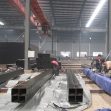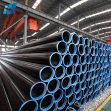Curtain Wall Details
In the traditional high-rise building construction, the structural load of the building was supported by thick load-bearing walls made of masonry. This had made a big change in the late 19th and early 20th century, as timber-frame and load-bearing masonry construction was supplanted by more efficient media like structural steel and concrete. No longer bound by the constraints of load bearing exterior walls, architects were able to apply lighter materials such as glass as an exterior finish, allowing for greater design flexibility as well as penetration of natural light. In the modern times, modern curtain wall designs are regarded the hallmark of the modern large cities. In practical applications, curtain wall systems provide a finished exterior appearance and most often a semi-finished interior as well. They are also designed to accommodate structural deflections, control wind-driven rain and air leakage, minimize the effect of solar radiation and provide for maintenance-free long term performance. Most of today’s systems are constructed of lightweight aluminum alloys or steel sections.

Applications of Curtain Wall Systems
In the context of architecture and design, the term “curtain wall” refers to a kind of non-structural exterior cladding, which can be fixed on to the load-bearing structure with its dead loads, imposed loads and wind loads transferred to the structure through fixings. In practical applications, in spite of the higher curtain wall costs than the traditional materials in building projects, modern curtain wall design do provide many benefits to buildings, such as:
1) Office buildings
2) Hotels
3) Shopping centers
4) Public/Functional buildings
5) Residential buildings
6) Other types
Merits of Using Curtain Wall In Buildings
1) Produce simple, neat and elegant building form
2) Provide larger unobstructed exterior wall area
3) Make the dead load of a building lighter due to the omission of solid external walls
4) Reduce the use of formwork and in-situ concrete during construction
5) Provide a reliable and almost maintenance-free external envelop for building
Common Types of Curtain Wall Systems for High-rise Buildings
1) Stick system
2) Unit system
3) Panel system
4) Unit and mullion system
5) Column-cover and spandrel system
6) Various types of glass wall system
High-rise Curtain Wall Buildings Functions & Performance Requirements
1) Strength and stability – dead load and wind load
2) Weather resistance – ability to keep out water & wind
3) Thermal insulation and condensation – max 30W/sq m
4) Sound insulation – 25dB or above
5) Fire resistance – usually no specific requirement if enough separating distance from relevant boundary is provided
Dong Peng Bo Da Steel Pipe Group is a famous steel pipe manufacturer in China. We are committed to producing various types of steel products for your choice in your building project in future. Our products are all designed for the fast and easy installation of curtain walls. Contact us if you have any need in your project.
Tel: +86 18202256900 Email: steel@fwssteel.com










